Mark Caney's Blog, page 16
May 7, 2015
Animal behaviour: Social networks of the dolphin kind
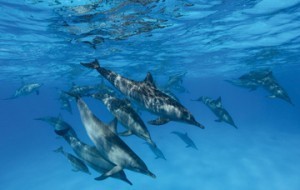 Like humans, dolphins too have networks of friends with specific preferences and aversions to fellow dolphins, a study has discovered.
Like humans, dolphins too have networks of friends with specific preferences and aversions to fellow dolphins, a study has discovered.
Scientists at Harbor Branch Oceanographic Institute (HBOI) at Florida Atlantic University took a closer look at the interactions between the social bottlenose dolphins in the Indian River Lagoon (IRL) to see the clear association patterns.
In their paper recently published in the journal Marine Mammal Science, the team wrote that individual dolphins have dolphins they like and associate with some and some they avoid.
The dolphins clustered into groups of associated animals, or “communities,” that tended to occupy discrete core areas along the north-south axis of the lagoon system.
Interestingly, the physical dimensions of the lagoon they occupied influenced their behaviour with fellow dolphins.
“For example, communities that occupy the narrowest stretches of the Indian River Lagoon have the most compact social networks, similar to humans who live in small towns and have fewer people with whom to interact,” said Elizabeth Murdoch Titcomb, research biologist at HBOI who worked on the study with Greg O’Corry-Crowe, PhD, associate research professor at HBOI; Marilyn Mazzoil, senior research associate at HBOI, and Elizabeth Hartel.
Intensive photo-ID surveys conducted along the IRL carried out over a six-and-a-half year period gave deeper insight into the lives and habitat preferences of 200 individual dolphins.
The study gives scientists and resource managers the roadmap to understand how dolphin populations perceive and use their environment, and how social networks will influence potentially breeding behavior and disease transmission.
Social animals
Earlier studies placed dolphins on the top level of animal cognitive sophistication, comparable to humans after showing their ability to recall events and individuals after 20 long years.
A University of Chicago study saw dolphins recall the whistles of former mates proving the complex social connections they have evolved.
Dolphins are known to have their own signature whistles that function similar to names in humans.
The ‘flipper’ or bottle-nosed dolphins called the Tursiops truncatus are widely distributed in cold temperate and tropical waters where they have the distinct inshore and offshore populations.
Research indicates they are conscious breathers and need to be awake or half-awake to breathe. Sleep occurs in a semi-conscious state and for few minutes only, says the Australian Dolphin Research Institute.
The main threat to dolphins is from habitat degradation and pollution, while disease and tourism pressures also poses significant dangers.
The IRL is a 156-mile long estuary located on Florida’s east coast. The lagoon is long and narrow and composed of three distinct water bodies; Mosquito Lagoon, Banana River, and the Indian River.
Researchers from HBOI have been conducting photo identification studies of IRL bottlenose dolphins since 1996, identifying more than 1,700 individual dolphins.
Among the findings enabled by this data is identification of a distinct IRL stock now breeding its third generation since the study began.
Source: International Business Times (By Jayalakshmi K)

Dolphin hunting in Solomon Islands requires urgent monitoring
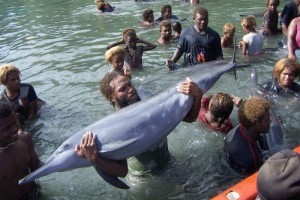 Traditional dolphin hunts in the Solomon Islands are among the world’s largest, researchers in the US have found, with over 1,600 dolphins killed in a 2013 hunt alone.
Traditional dolphin hunts in the Solomon Islands are among the world’s largest, researchers in the US have found, with over 1,600 dolphins killed in a 2013 hunt alone.
A study in Fanalei village, on the island of South Malaita, recorded an overall tally of 15,400 dolphins killed between 1976-2013 .
The dolphins are mainly killed for their teeth, a local currency often used to pay dowries for brides and for ceremonial jewellery.
Despite recent attempts from environmentalists and government to stamp out the practise, the local price of a dolphin tooth rose from the equivalent of 14 US cents in 2004 to about 70 US cents in 2013.
“The large number of dolphins killed and the apparent incentive for future hunting offered by the increasing commercial value of teeth highlight an urgent need to monitor hunts and assess the abundance and trends in local populations,” the report, published in the journal Royal Society Open Science, said.
The Solomon Islands has a long history of “drive hunting”, however it is now limited to just a few villages.
Hunters in groups of 20-30 canoes drive dolphin schools from deep to coastal waters by hitting stones together. This creates a sound barrier underwater that drives the mainly spinner and spotted dolphins towards shore where they are killed.
Researchers said while the hunt did not pose a threat to the species, it did have the potential to wipe out small and isolated dolphin communities.
“We’ve learned over the years that many populations of dolphins are highly subdivided,” co-author Scott Baker, from Oregon State University, told Pacific Beat.
“That is, they’re localised around islands forming small communities. It’s the loss of those communities that is the threat here.”
Dr Baker said village leaders in South Malaita were receptive to ideas that would protect the resource.
“They’d like to continue the tradition into the future and that might not be possible if they’re overexploiting local populations,” he said.
Dive hunting was first documented in the Solomon Islands during the early 20th century, the report states.
But it remains unclear when and where the hunt was initiated or introduced into the culture.
Oral history from Fanalei village suggests it might have stopped with the arrival of Christianity around the middle of the 19th century.
But, according to the study, it was revived in 1948, and by the mid-1960s several thousand dolphins were being killed every year.
Full story: ABC News

May 6, 2015
Captive dolphins to be used to entice holiday home buyers
 An Indonesian developer says Singapore buyers are showing keen interest in a project promising villas built over the sea, with dolphins at the residents’ doorsteps. Batam-based developer PT Batam Island Marina and its Singapore investment partner Seven Seas FID are planning 64 villas, each shaped like a round bamboo hut and built around a lagoon with dolphins which residents can feed and play with. Priced at $758,000 each, the villas were launched here two weeks ago with a blaze of advertisements showing dolphins leaping out of the water, and the Marina Bay Sands skyline on the horizon. The project is coming up in the midst of six small islands known collectively as Pulau Manis, 3km off Batam. Each villa has two bedrooms and is about the size of a Housing Board executive flat. The developer has promised shops and restaurants nearby, but has been mum about maintenance costs and whether residents must pay for the dolphins’ upkeep. Half the units went on sale at a swanky showroom in the upmarket One Degree 15 marina on Sentosa two weeks ago. A visit there found the place buzzing at the launch.
An Indonesian developer says Singapore buyers are showing keen interest in a project promising villas built over the sea, with dolphins at the residents’ doorsteps. Batam-based developer PT Batam Island Marina and its Singapore investment partner Seven Seas FID are planning 64 villas, each shaped like a round bamboo hut and built around a lagoon with dolphins which residents can feed and play with. Priced at $758,000 each, the villas were launched here two weeks ago with a blaze of advertisements showing dolphins leaping out of the water, and the Marina Bay Sands skyline on the horizon. The project is coming up in the midst of six small islands known collectively as Pulau Manis, 3km off Batam. Each villa has two bedrooms and is about the size of a Housing Board executive flat. The developer has promised shops and restaurants nearby, but has been mum about maintenance costs and whether residents must pay for the dolphins’ upkeep. Half the units went on sale at a swanky showroom in the upmarket One Degree 15 marina on Sentosa two weeks ago. A visit there found the place buzzing at the launch.
A team of about 10 salesmen dressed in suits attended to a steady stream of walk-in prospects, showing them a multimedia presentation, artists’ impressions and a scale model of the villas, before discussing the financing plans over snacks, coffee and soft drinks. According to Funtasy Island Development, a Singapore firm set up in 2010 to market the dolphin villas and other homes on Pulau Manis, there is no shortage of buyers. Director Michael Yong declined to give exact figures but said the initial sales “exceeded expectations”. A Malaysian with Singapore permanent residency, he owns 30 per cent of Funtasy Island Development. The rest is owned by Indonesian businessmen Ade Soehari and Luky Winata. The project is coming up in an area owned by PT Batam Island Marina. Foreigners cannot own land in Indonesia but can be granted 25-year leases which can be extended in 20-year blocks. The Indonesian company has promised on its website to renew Funtasy Island’s leases up to 2112.
Full story: AsiaOne Business
See here for the concerns raised by this issue.

April 27, 2015
April 22, 2015
WAZA Council votes to suspend Japanese Association of Zoos and Aquariums (JAZA)
From WAZA website:
Following years of negotiations over animal acquisition policies, WAZA Council voted unanimously this week to suspend membership of JAZA.
The World Association of Zoos and Aquariums (WAZA) Council voted unanimously this week to suspend the membership of the Japanese Association of Zoos and Aquariums (JAZA). The decision comes after WAZA and JAZA could not reach agreement on issues involving JAZA member zoos and aquariums taking dolphins from the Japanese drive fishery.
WAZA requires all members to adhere to policies that prohibit participating in cruel and non-selective methods of taking animals from the wild.
For a number of years, WAZA has attempted to work collaboratively with JAZA and its members to stop the collection of animals from the Taiji drives fisheries. Annually the drives draw international attention and criticism for the killing of dolphins and WAZA has previously joined other organizations in speaking out against the practice.
WAZA made ongoing attempts to negotiate the issues including during a meeting in Tokyo last year when WAZA proposed that JAZA enforce a two-year moratorium on taking animals from the drive by its members. The moratorium was rejected by JAZA. The issue was discussed again at WAZA’s international conference in November with a goal to influence change in JAZA’s position on members accepting animals from the drive fisheries. JAZA responded by proposing some guideline changes that would put restrictions on the method of capturing dolphins and improving animal care, but because it did not restrict taking animals from the drive, WAZA Council concluded that a satisfactory agreement could not be reached and voted to suspend the Japanese association’s membership.
The basis for the suspension is a determination that JAZA has violated the WAZA Code of Ethics and Animal Welfare. Moreover, WAZA Council re-affirmed its position that members of WAZA must confirm that they will not acquire dolphins from the Taiji fishery.
WAZA’s mission is to serve as the voice of a worldwide community of zoos and aquariums and a catalyst for their joint conservation action. One of the ways WAZA accomplishes this mission is through promoting cooperation between national and regional associations. It is important to note that WAZA still remains committed to continuing discussions with JAZA and its members in an effort to end the loss of animal life through the drive fisheries.
Source: WAZA

April 17, 2015
Evolutionary history of whales, dolphins and sea turtles
Whales, dolphins, seals and sea turtles are members of an exceptional group of animals, called marine tetrapods, that have moved from the sea to the land and back to the sea again over the last 350 million years — each time making radical changes to their life style, body shape, physiology and sensory systems.
“These land-to-sea transitions act like repeated evolutionary experiments,” said Neil Kelley, a former lecturer in earth and environmental sciences at Vanderbilt University and a post-doctoral researcher at the Smithsonian National Museum of Natural History’s department of paleobiology. “We can learn quite a bit about evolution by comparing the similarities and differences in each group.”
Kelley is the lead author of a new scientific review performed by scientists at the Smithsonian who have synthesized decades of scientific findings regarding the changes that these land species underwent in order to thrive in the marine environment. He began the research while at Vanderbilt and finished it up at the Smithsonian. The study results are published in the Apr. 17 issue of the journal Science.
Marine tetrapods represent a diverse group of living and extinct species of mammals, reptiles, amphibians and birds that all play, or have played, a critical role as large ocean predators in marine ecosystems past and present.
The reverse migration of land animals back to the ocean began 250 million years ago, following the Great Permian Extinction, colloquially known as the Great Dying because it was the most severe mass extinction event known, with 96 percent of all marine species and 70 percent of land animals going extinct. It took the Earth’s ecosystems up to 10 million years to recover.
“We know from the fossil record that previous times of profound change in the oceans were important turning points in the evolutionary history of marine species,” said Kelley. “Today’s oceans continue to change, largely from human activities. This paper provides the evolutionary context for understanding how living species of marine predators will evolve and adapt to these changes.”
According to the paleobiologist, there is even evidence that some species may have been double dippers: They have transitioned between sea and land more than once.
Full story: Vanderbilt University

April 15, 2015
10 Facts for National Dolphin Day
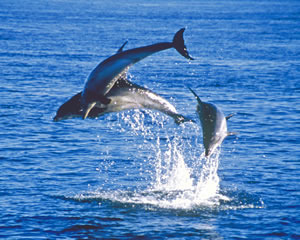 So, today is National Dolphin Day. Of course dolphins seem happy every day – but here are ten special things you might not know about the ocean’s biggest grinners:
So, today is National Dolphin Day. Of course dolphins seem happy every day – but here are ten special things you might not know about the ocean’s biggest grinners:
Killer whales are dolphins
Yes, the big mean orcas are just big misunderstood dolphins. They are top dog in every ocean ecosystem, despite being dressed in silly panda suits.
Dolphins are born tail first
Being a mammal and giving birth at sea is no mean feat, and every baby dolphin comes into the world in reverse. If you’re lucky enough to see a very young dolphin you might also notice that they look ‘creased’ from where they were folded up inside their mothers. A healthy diet of fatty dolphin milk soon irons out those creases though.
Dolphins have built in sonar
Dolphins navigate and find their food using echolocation. This bounces noise off objects and their surroundings to ‘see’ in surround sound. Bats also use echolocation in this way, but sadly dolphins have never been immortalised as a caped comic crusader.
Dolphins rescued Dick Van Dyke!
No, this is not a deleted scene from Mary Poppins! In 2010 cinema legend Dick Van Dyke claimed that his life was saved by ‘porpoises’. Though he probably meant dolphins. Or he may have been talking supercalifragilisticexpialinonsense.
Scottish dolphins are the best
Okay, maybe not the best, but Scottish bottlenose dolphins are the biggest in the world. Probably because Scottish seas are a bit chilly as every child who has been to St Andrews beach in ‘summer’ knows to their cost, and being bigger means you lose less heat. Scottish dolphins are also pretty easy to see from shore, or on a boat trip, and support a thriving ecotourism industry in the Moray Firth.
Some dolphins live in the trees
Not all dolphins live in the sea, with a handful of species preferring freshwater and living in tropical rivers. That means that in the flooded waters of the amazon, river dolphins swim amongst the trees.
Dolphins have central heating & cooling systems
Because they are covered in a blubbery coating to stay warm, dolphins have to take special measures to regulate their temperature. They use clever circulation to cool down blood in their fins and send it where staying cool matters most.
Dolphins call each other names
No, not mean names like ‘Fishbreath’ or ‘Beaky’! Scientists have discovered that complex dolphin communication includes referring to each other by a given ‘name’.
Not all dolphins look the same
There are about 40 species of dolphins: some have no beak, some have no fin on their back, some are black and white, some are pink, some have go-faster stripes, and some are covered in scars. The one thing they do have in common is conical shaped teeth that are perfect for catching fish and squid on the move.
Source; Greenpeace

April 2, 2015
Court Rules US Navy War Games Violate Law Protecting Whales and Dolphins
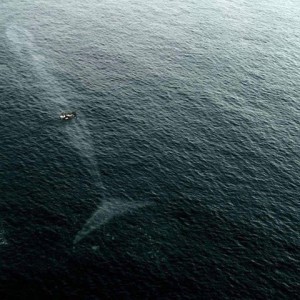 U.S. District Court deems that nearly 9.6 million underwater assaults on whales and dolphins were improperly assessed as “negligible”
U.S. District Court deems that nearly 9.6 million underwater assaults on whales and dolphins were improperly assessed as “negligible”
LOS ANGELES (March 31, 2015) —A federal court today announced that the U.S. Navy’s training and testing activities off the coast of Southern California and Hawaii illegally harm more than 60 whale, dolphin, seal, and sea lion populations. The U.S. District Court, District of Hawaii, found that the National Marine Fisheries Service – the agency charged with protecting marine mammals – violated multiple requirements of the Marine Mammal Protection Act and the Endangered Species Act when agreeing to the Navy’s plan.
“Searching the administrative record’s reams of pages for some explanation as to why the Navy’s activities were authorized by the National Marine Fisheries Service (‘NMFS’), this court feels like the sailor in Samuel Taylor Coleridge’s ‘The Rime of the Ancient Mariner’ who, trapped for days on a ship becalmed in the middle of the ocean, laments, ‘Water, water every where, Nor any drop to drink.’” the Court wrote in its 66-page opinion.
The case before the Court was brought by the Natural Resources Defense Council, Cetacean Society International, Animal Legal Defense Fund, Pacific Environment and Resources Center, and Michael Stocker.
In 2014, the case was consolidated for administrative purposes with another action (Conservation Council for Hawaii v. National Marine Fisheries Service) challenging the government’s authorizations of Navy activities in Hawaii and Southern California. Today, the Court also ruled against the government in that action.
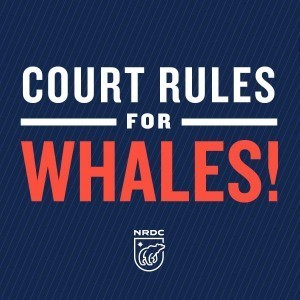 Under its five-year plan for training and testing, the Navy is permitted to harm whales, dolphins, and other marine mammals nearly 9.6 million times while conducting high-intensity sonar exercises and underwater detonations. These harmful impacts include millions of instances of temporary hearing loss and significant disruptions in vital behaviors, such as habitat abandonment, as well as permanent hearing loss, permanent injury and more than 150 deaths.
Under its five-year plan for training and testing, the Navy is permitted to harm whales, dolphins, and other marine mammals nearly 9.6 million times while conducting high-intensity sonar exercises and underwater detonations. These harmful impacts include millions of instances of temporary hearing loss and significant disruptions in vital behaviors, such as habitat abandonment, as well as permanent hearing loss, permanent injury and more than 150 deaths.
Ocean noise is one of the biggest threats worldwide to the health and well-being of marine mammals, which rely on sound to ‘see’ their world. Navy sonar activities, shipping noise, and seismic exploration by oil and gas companies have made our oceans noisier in recent decades, resulting in widespread disruption to feeding, communication, mating, and more.
Following is a statement by Zak Smith , attorney with the Natural Resources Defense Council’s Marine Mammal Protection Project, representing plaintiffs:
“Defenseless marine mammals are going deaf and hungry and may die at the hands of our Navy. And the laws we have that are meant to limit such harms have been misused by the government.
“Instead of downplaying the impacts on marine mammals – including endangered blue, fin and humpback whales – the government should be doing more to protect them from these harmful activities.
“The Navy has solutions at its disposal to ensure it limits the harm to these animals during its exercises. It’s time to stop making excuses and embrace those safety measures.”
Source: NRDC
March 30, 2015
Exhausted dolphins rescued from shallow lake in Western Australia
Footage released by the West Australian Department of Parks and Wildlife shows two stranded bottlenose dolphins being rescued from a lake, near Mandurah, south of Perth. They swam up a river possibly chasing fish. The dolphins could not swim back to deep water because swimming in shallow lake water had exhausted them.
Source: The Guardian
March 29, 2015
Free competition for a copy of Dolphin Way ends on 1st April (no, really)
Goodreads Book Giveaway

Dolphin Way
by Mark Caney
Giveaway ends April 01, 2015.
See the giveaway details
at Goodreads.







